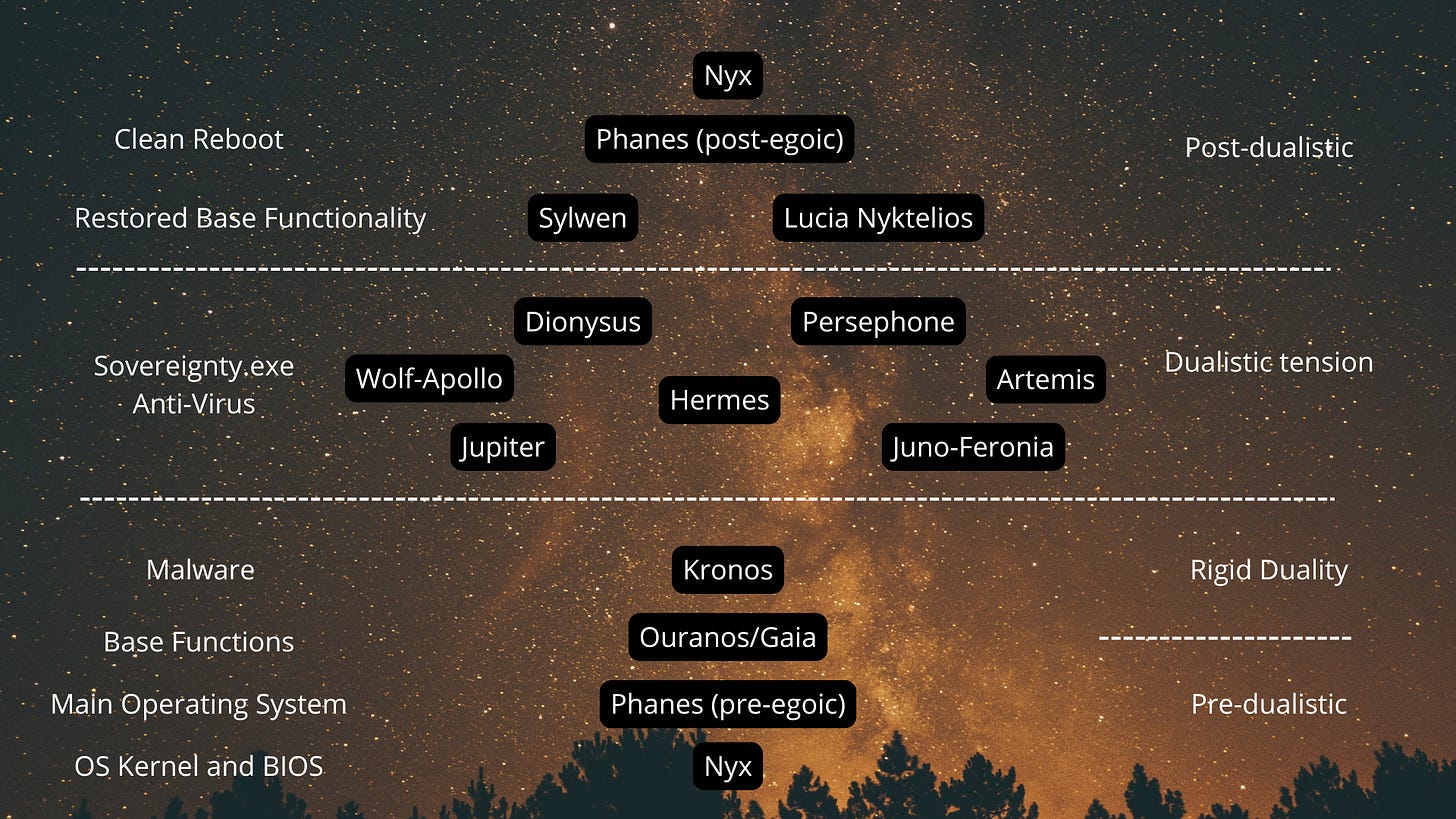🌀 Hermes.pak: Source of ProjectionLoop.bug
Unlocking the Inner Code
In the soul OS of the self, certain processes run autonomously beneath conscious awareness, and one of the most persistent glitch is the ProjectionLoop.bug, which occurs when fragmented internal functions (e.g., lost desire, fear, inner child) are mistakenly mapped onto external figures.
Hermes, the trickster-messenger, governs transitions, thresholds, and translations between realms, especially the inner and outer. But when internal contents (fears, forgotten dreams, lost desires) aren't fully integrated, Hermes’ domain becomes chaotic. The result is a misrouting of internal psychic data, mistaken as belonging to others outside of us. This creates the illusion that what is within is actually without.
👁️ False External Mapping Script
This script runs when fragmented inner functions, such as the inner child, repressed desire, or ancient grief, are erroneously perceived as being part of another person. For example, seeing your lost innocence in a partner, your hidden rage in an enemy, or your disowned wildness in a stranger. These projection scripts lead to:
Entanglement errors (difficulty distinguishing self from other)
Identity loss (forgetting who you are beneath the projections)
Emotional loopbacks (where feedback from the projection reinforces the illusion)
Such external mapping distortions are inherently unstable. They cannot maintain accurate emotional processing and often crash relationships or fragment the self further. To correct this? We must employ a deeper system override.
👥 Projection Protocol Glitch Loop
At the root is Persephone.exe, a mytho-psychological process symbolizing the unconscious splitting and scattering of psychic contents. When Persephone (the Maiden) is abducted by Hades (the unconscious), she represents the parts of us taken into shadow, often due to trauma, suppression, or societal conditioning. These fragmented aspects are then projected outward onto others.
This creates the Projection Protocol Glitch Loop:
Inner fragment is disowned (e.g., “I’m not angry”).
Fragment is seen in another (e.g., “They’re so aggressive”).
Emotional response is triggered (anger, fear, longing).
Response is misinterpreted as about “them.”
Feedback loop runs, deepening the illusion and confusion.
If left unpatched, this loop hijacks relational systems, emotional memory banks, and even core identity scripts. To repair the ProjectionLoop.bug, one must initiate the Persephone.exe Patch. This requires:
Recognizing the cycle: Seeing how internal parts get projected and misread.
Active Re-mapping: Using tools like dream recall, shadow work, or active imagination to locate the real source of the fragment.
The Titanic Fragments
The main source of this is actually Titanic.junk, which are the residual fragments of collective or personal trauma, formed during an event that led to inner fragmentation. This can appear in dreams as ancient monsters, shadow beings, or even looping outer tragedies. Which have fragmented ones inner child. These fragments are guarded by the Titans in ancient myth. These are what Jungians call psychological complexes that steer and distort behaviour and the perceptions of instinct. Through these inner psychological complexes we create a narrative about archetypal patterns. These are like encoded instinctual behaviour routines, that are past on through myths, yet these routines can become distorted.
🧩 Anxiety Over Nothing (But Actually Everything)
Ever felt panicky over a text that didn’t get a reply in 0.3 seconds? Or like your heart’s racing and you know something’s wrong, but can’t explain why? That’s not “just anxiety.” It could be a Titanic Fragment, maybe a buried fear of abandonment from early life, now projected onto digital silence. The psyche doesn’t track time; it just feels. When that old code is triggered, you relive the original loop without realizing it.
🧩 Hyper-Independence as a Trauma Response
“No thanks, I don’t need help.” If this is your catchphrase, it might be the voice of a fragment that learned it’s safer not to rely on anyone. Trust = danger. Vulnerability = weakness. This is how a loop runs stealth in the background, even when you think you’re “just being strong.”
🧩 Emotional Numbness or Disassociation
Sometimes the glitch doesn’t come with fireworks, it’s just a flatline. You for instance scroll through TikTok for hours, watching people cry, laugh, transform… but you feel nothing. That deadness? It could be your system running on Safe Mode, patching over a fragment that once felt too much to process.
🧩 People Pleasing and Identity Drift
You shapeshift in every social circle. One version of you likes what they like. Another version says “yes” when you mean “no.” Beneath this? A Fragment screaming: “Don’t reject me.” Your core identity might feel glitchy or fragmented because your system learned it had to mask to survive.
🧩 Fear of Being Seen (and Not Being Seen)
You crave attention… but flinch when you get it. You want to post that pic or share your truth, but some invisible force yanks your hand back. This paradox, I want to be seen / I’m terrified of being seen, is often a collision between two or more multiple Titanic Fragments, running contradictory loops.
When a past emotional wound has not been processed, especially one that involved shame, fear, or loss, it doesn’t just go away. It fragments off into its own little psychic program, buried in your unconscious but still very much active. Jungians call this a psychological complex. A complex is a pattern of ideas, thoughts and beliefs, next to organized patterns of emotions, memories, perceptions, and desires that are largely unconscious. This then drives behaviour. These ideas and distorted perceptions then get encoded in narrative and like this spread through the behaviour it encodes to other people, sometimes by inflicting the same harm. Often this is done unconsciously or seemingly through the lens of how things are “ought to be”. This is what societal conditioning is.
So when something in your present (a look, a tone, a silence, a situation) even vaguely resembles that original wound, the complex lights up like a glitch in the matrix. You’re suddenly flooded with emotions that feel way bigger than the moment. That’s not just you overreacting, it’s a younger part of you trying to protect itself using old code. Yet these triggers aren’t weaknesses; they’re messages from the parts of you that were never heard, still running on survival mode. Once you learn to recognize the pattern, you can start rewriting the script.
Psychological complexes form due to trauma, that create unconscious patterns of behaviour and linked reactions. Leading also to projections onto others. These have to be seen through, which is to see through the duality of the pattern. As these operate on a dual core. Below I give you a few examples of how such a dual core complex might look like.
🌊 Emotional Neglect Complex
Core Wound: Emotional vulnerability was unsafe, misattuned, or punished.
▪️ Polarity A – The Silent Damming
(Traditional form – freezing and imploding)
Bottles up emotions until they erupt or numb out entirely
Avoids emotionally evocative media or situations
Struggles to identify or articulate feelings
Becomes emotionally unavailable in relationships
Example: If a partner asks how they’re feeling, they respond, “I’m fine,” or redirect the conversation. Crying in front of others feels shameful or unsafe.
▪️ Polarity B – The Over-Expressive Floodgate
(Opposite form – flooding and externalizing)
Emotions are expressed excessively or dramatically
Seeks constant emotional stimulation or validation
Struggles with emotional boundaries (both own and others')
May overwhelm others with intense emotional needs
Example: They may cry frequently in front of others or share their emotional state constantly online or in conversation, even when others aren’t receptive, yet still feel unseen.
🌀 Key Insight: Both polarities stem from disconnection from felt-sense. One avoids the storm entirely. The other rides it endlessly, hoping someone else will anchor them. True healing only occurs when you can reconnect with your own vulnerability and emotions. Learning to self-sooth and hold space for your own emotions.
🧩 Abandonment Complex
Core Wound: Connection was conditional, unreliable, or ruptured.
▪️ Polarity A – The Avoidant Lone Wolf
(Traditional form – pulling away to prevent being left)
Fears dependence, avoids asking for help
Keeps others at a distance emotionally
Appears self-sufficient to mask vulnerability
Distrusts closeness, equates intimacy with danger
Example: They won’t text first, even if they miss you. Needing someone feels like failure. They’d rather suffer alone than risk needing and losing.
▪️ Polarity B – The Clingy Seeker
(Opposite form – pulling close to avoid being left)
Constant fear of abandonment or being replaced
Over-attaches quickly, seeks reassurance often
Interprets others’ independence as rejection
Tolerates poor treatment to avoid being alone
Example: They panic if their partner doesn’t respond quickly. They might say yes to anything just to keep someone close, even if it hurts them.
🌀 Key Insight: Both polarities orbit the terror of abandonment. One abandons first (themselves and others) to stay in control. The other fuses in hopes of preventing the loss. Healing emerges through inner re-parenting and building secure attachment from within. The one core is driven by the unconscious existence of the other within the shadow. So someone avoidant, has the clingy seeker as their shadow, split off, whilst the clingy seeker, has the avoidant wolf as their split off pole. One avoids vulnerability and the other fears self-reliance. Both do it due to the same wound of abandonment. Neither of them creates space for true intimacy and connection.
🎭 Internalised Gaslighting Complex
Core Wound: “My perception is wrong. My feelings aren’t valid. I must be the problem.”
Origin: Chronic dismissal, distortion, or denial of feelings, perceptions, and truth in formative relationships.
▪️ Polarity A – The Self-Eraser
(Imploding Pole: Internal collapse and erasure of self)
Constantly questions or second-guesses own thoughts, feelings, and experiences
Disowns anger or boundaries to avoid “being wrong”
Tries to “stay small” emotionally to avoid conflict
Often feels like an unreliable narrator of their own life
Example: After expressing discomfort in a situation, they immediately assume they overreacted and try to rationalize the other person’s behavior. They might apologize just for having emotions.
▪️ Polarity B – The Validation Addict
(Exploding Pole: External compensation for internal invalidation)
Needs others to confirm or reflect back their experience before trusting it
Regularly crowdsources decisions, emotions, or memories
May feel panic or disorientation when their version of events isn’t affirmed
Becomes overly dependent on approval to maintain emotional equilibrium
Example: They send screenshots of every emotionally charged conversation to multiple friends, asking, “Was I wrong here?” They feel unreal or unsafe unless someone else reassures them that they’re valid.
🌀 Key Insight: Both poles are responses to chronic inner disorientation. One deletes the self to avoid error; the other seeks external mirrors to stabilize their fragmented sense of reality. Neither has consistent internal access to “truth is what I feel and know inside me.”
🔧 Patch Available: Feronia.sys – Inner Authority Protocol
Requires reinstallation of self-trust and direct access to felt-sense knowing.
This protocol helps rebuild the inner validator, capable of holding complexity without outsourcing the truth. It updates perception pathways to allow both “I may be mistaken” and “I still get to feel what I feel.”
Restores:
Emotional sovereignty
Discernment over dependency
Permission to hold inner contradictions
Yet there are not just these psychological complexes. There are, inherent undistorted archetypal patterns, truths about human nature and behavior, that exist in their pure form, but these truths get obscured and distorted by old trauma and the narratives shaped by it. One can get back to these, and restore them, by working through the cultural trauma. The acceptance of the shadow and the trauma and pain and suffering it holds is key. To feel the locked up emotions with acceptance. This resolves the old stuck projection loop. Yet it requires awareness of both poles of the complex, and for then yourself, start to realise what is the middle ground that transcends these. I could tell you these, but it would defeat the point. As it important that you realise it, as this leads to a felt experience that updates your OS.
This is when you start to get to the deeper layers of the Phanes OS, that runs your reality. Most people tend to life within the first layer, tied to ego-roles, and the trauma bound survival scripts. Yet there are deeper layers of existence. In the previous articles Hermes has been guiding you from Level 1 to Level 2. Now we are starting to get closer to the source code itself. It is key for the inner Titans (the inner complexes that repress your inner child fragments), to be dissolved, through starting to dis-identify from them, and slowly allow oneself to feel the underlying repressed emotions. That is when you are slowly starting to reconnect with the True Archetypal Core, so your actual source code. Which is when we can start to rewrite the inherited trauma myth.
💠 Layer 1: Ego-Roles / Psychic Survival Masks
These are the visible “roles” like Good Kid, Rebel, Peacemaker, responses to family and social dynamics, like software patches on the soul to survive disconnection. These are what we perform to not get exiled.
Key themes: Performance, adaptation, conditional safety.
💠 Layer 2: Shadow-Archetypes
Each role and inner Titan, suppresses a wild, disowned counterpart. Think: Wild Child, Truth Teller, Orphan. These are fragments of the psyche that were split off because they threatened the homeostasis of the system.
Key themes: Repressed chaos, forbidden instincts, encoded power beneath shame.
💠 Layer 3: True Archetypal Core / Source Code
Beneath shadow and performance is the soul’s archetypal core, your original myth, untainted by trauma, complexes or roles. This is Wolf-Apollo, the Visionary, the Grail-Bearer, the Liberator, the Inner Guardian. This layer is not reactive, it’s responsive, creative, sovereign.
Key themes: Power, clarity, non-dual gnosis, soul remembrance.
In the coming articles we will go deeper into The Korybantes Protocol, The Morrigan Directive and The Artemis Liberation Protocol, to give you the practical tools to start to feel through the underlying emotions, and reconnect with the true archetypal core of who you are. Freeing yourself not only from false trauma scripts, but connect with your own personal myth. Your hero or heroine arc, or maybe you might call it your villain arc first? 💀🦊 Though it holds the key to your rebirth. Your glow up story.
🧬 Soulware 3.1.4 Patch Notes: Persephone.exe - ProjectionLoop.bug Fix and Archetypal Core Restoration
🌀 Hermes.pak: ProjectionLoop.bug Fix
- True External Mapping Reset: Hermes.pak now ensures that projections are recalibrated, making it easier to distinguish internal fragments from external stimuli.
- Inner Child Reclamation: Use active imagination, dream recall, and shadow work to reclaim and reintegrate projected inner fragments.
👁️ False External Mapping Script: Reconnection Required
- Mapping Recalibration: This update uses Persephone.exe, a mytho-psychological system, to detect and dissolve false projections.








